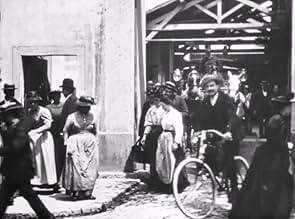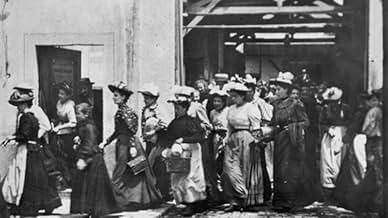A Saída dos Operários da Fábrica Lumière
Título original: La sortie de l'usine Lumière à Lyon
AVALIAÇÃO DA IMDb
6,8/10
8 mil
SUA AVALIAÇÃO
Adicionar um enredo no seu idiomaWorkers leaving the Lumière factory for lunch in Lyon, France in 1895; a place of great photographic innovation and one of the birth places of cinema.Workers leaving the Lumière factory for lunch in Lyon, France in 1895; a place of great photographic innovation and one of the birth places of cinema.Workers leaving the Lumière factory for lunch in Lyon, France in 1895; a place of great photographic innovation and one of the birth places of cinema.
- Direção
Avaliações em destaque
The appeal of ancient films like this one is that you get to see an actual moving image of life over 100 years ago. Here are a lot of people leaving a factory, all of them dead by now and none of them even remotely aware of the magnitude of the invention that they are walking before. I was shocked to read one reviewer call this film as boring as home videos today, and at least one other mistakenly identified it as the first film ever made (it was the first film made at the rate of 16 frames per second, rather than the then-normal 46 frames per second).
Sure, all you see is a lot of people filing out of a building and passing before the cinematograph on their way home from work, but this is a curiosity piece for dozens of reasons, not the least of which is that it was the first film made by the Lumiére brothers, who probably had a stronger impact on the development of the cinema than any other individual or group of individuals in history.
Sure, all you see is a lot of people filing out of a building and passing before the cinematograph on their way home from work, but this is a curiosity piece for dozens of reasons, not the least of which is that it was the first film made by the Lumiére brothers, who probably had a stronger impact on the development of the cinema than any other individual or group of individuals in history.
On the 28th of December, 1895, in the Grand Café in Paris, film history was writing itself while Louis Lumière showed his short films, all single shots, to a paying audience. 'La Sortie des Usines Lumière' was the first film to be played and I wish I was there, not only to see the film, but also the reactions of the audience.
We start with closed doors of the Lumière factory. Apparently, since the image seems a photograph, people thought they were just going to see a slide show, not something they were hoping for. But then the doors open and people are streaming out, heading home. First a lot of women, then some men, and one man on a bike with a big dog. When they are all out the doors close again.
Whether this is the first film or not (some say 'L'Arrivée d'un Train à la Ciotat' was the first film Lumière recorded), it is an impressive piece of early cinema. Being bored by this is close to impossible for multiple reasons. One simple reason: it is only fifty seconds long. But also for people who normally only like the special effect films there must be something interesting here; you don't get to see historical things like this every day.
We start with closed doors of the Lumière factory. Apparently, since the image seems a photograph, people thought they were just going to see a slide show, not something they were hoping for. But then the doors open and people are streaming out, heading home. First a lot of women, then some men, and one man on a bike with a big dog. When they are all out the doors close again.
Whether this is the first film or not (some say 'L'Arrivée d'un Train à la Ciotat' was the first film Lumière recorded), it is an impressive piece of early cinema. Being bored by this is close to impossible for multiple reasons. One simple reason: it is only fifty seconds long. But also for people who normally only like the special effect films there must be something interesting here; you don't get to see historical things like this every day.
Story says that on that on December 28, 1895, a small group of thirty-three people was gathered at Paris's Salon Indien Du Grand Café to witness the Cinématographe, a supposedly new invention that resulted from the work done by a couple of photographers named August and Louis Lumière. The small audience reunited that day (some by invitation, most due to curiosity) didn't really know what to expect from the show, and when a stationary photograph appeared projected on a screen, most thought that the Cinématographe was just another fancy devise to present slide-show projections. Until the photograph started to move. What those thirty-three people experienced in awe that cold day of December was the very first public screening of a moving picture being projected on a screen; history was being written and cinema as we know it was born that day.
Of the 10 short movies that were shown during that historic day, "La Sortie Des Usines Lumière" (literally "Exiting the Lumière Factory") was the very first to be screened. The film shows the many workers of the Lumière factory as they walk through the gates of the factory, leaving the building at the end of a hard day of work. While a very basic "actuality film" (movie depicting a real event), the movie took everyone in the audience by surprise, as their concept of moving pictures was limited to Edison's "Peep Show" machines (the Kinetoscope), the brothers' invention was like nothing they had seen before and so the audience stood in awe, as the people and the horses moved across the screen. The idea wasn't entirely new (Le Prince shot the first movie as early as 1888), but the way of showing the movie was simply revolutionary.
"La Sortie Des Usines Lumière" would become the first in the long series of "actuality films" that the Lumière would produce over the years. This primitive form of documentary was the brothers' favorite kind of film because they were more interested in the technological aspects of their invention than in the uses the Cinématographe could have. Despite the initial lack of enthusiasm, after the first showing the Cinématographe became a great success and "La Sortie Des Usines Lumière" quickly became an iconic image of that first screening. It definitely wasn't the first movie the brothers shot that year, and it probably wasn't the best of the 10 movies shown that day (personally I think that "L' Arroseur Arrosé" was the best of the 10); however, it is really meaningful that the very first movie was the opening of a pair of gates, as literally, this movie opened the gates to cinema as we know it. 8/10
Of the 10 short movies that were shown during that historic day, "La Sortie Des Usines Lumière" (literally "Exiting the Lumière Factory") was the very first to be screened. The film shows the many workers of the Lumière factory as they walk through the gates of the factory, leaving the building at the end of a hard day of work. While a very basic "actuality film" (movie depicting a real event), the movie took everyone in the audience by surprise, as their concept of moving pictures was limited to Edison's "Peep Show" machines (the Kinetoscope), the brothers' invention was like nothing they had seen before and so the audience stood in awe, as the people and the horses moved across the screen. The idea wasn't entirely new (Le Prince shot the first movie as early as 1888), but the way of showing the movie was simply revolutionary.
"La Sortie Des Usines Lumière" would become the first in the long series of "actuality films" that the Lumière would produce over the years. This primitive form of documentary was the brothers' favorite kind of film because they were more interested in the technological aspects of their invention than in the uses the Cinématographe could have. Despite the initial lack of enthusiasm, after the first showing the Cinématographe became a great success and "La Sortie Des Usines Lumière" quickly became an iconic image of that first screening. It definitely wasn't the first movie the brothers shot that year, and it probably wasn't the best of the 10 movies shown that day (personally I think that "L' Arroseur Arrosé" was the best of the 10); however, it is really meaningful that the very first movie was the opening of a pair of gates, as literally, this movie opened the gates to cinema as we know it. 8/10
This is it!! if your looking for a thrilling few minutes of the French leaving work then it does not get any better than this.Action to look out for includes,
French woman walking at the screen, French bloke wobbling on his bike, The closing of the gates cliff-hanger Finale.
Oh and its maybe the most important few minutes in the history of cinema.
French woman walking at the screen, French bloke wobbling on his bike, The closing of the gates cliff-hanger Finale.
Oh and its maybe the most important few minutes in the history of cinema.
This one-minute film is arguably the first movie ever made. Other inventors had previously filmed actions - like Edison's motion photography of a sneeze - but the Lumiere brothers developed equipment that tremendously advanced the medium. At the time, of course, their `cinematograph' must have bewildered their peers, including their subjects. In this first instance, the brothers record employees leaving their factory, some of whom understandably struggle to hide their awareness of the camera. The Lumieres attempt to make the film more entertaining by introducing animals and a bicycle, but `La Sortie Des Usines Lumiere' doesn't nearly match the ingenuity of their later films. The most interesting aspect of this short film is the brothers' selection of a familiar working class ritual as their subject. Their choice is the initial evidence of their curiosity about all of the world's people, a quality that makes viewing their experiments immensely rewarding and fascinating today.
Rating: 8
Rating: 8
Você sabia?
- CuriosidadesIt was the first film ever to be projected to a paying audience.
- Versões alternativasThree versions of the film exist. There are a number of differences between them, such as the clothing styles worn by the workers change to reflect the different seasons the versions were shot in, and the horse-drawn carriage that appears in the first version is pulled by one horse, two horses in the second version, and no horse and no carriage in the third version.
- ConexõesEdited into The Lumière Brothers' First Films (1996)
Principais escolhas
Faça login para avaliar e ver a lista de recomendações personalizadas
Detalhes
- Data de lançamento
- País de origem
- Centrais de atendimento oficiais
- Idioma
- Também conhecido como
- Employees Leaving the Lumière Factory
- Locações de filme
- Empresa de produção
- Consulte mais créditos da empresa na IMDbPro
- Tempo de duração1 minuto
- Cor
- Mixagem de som
- Proporção
- 1.33 : 1
Contribua para esta página
Sugerir uma alteração ou adicionar conteúdo ausente

Principal brecha
By what name was A Saída dos Operários da Fábrica Lumière (1895) officially released in India in English?
Responda



















